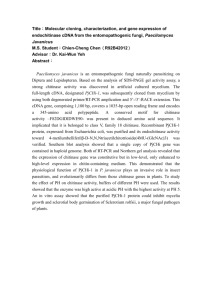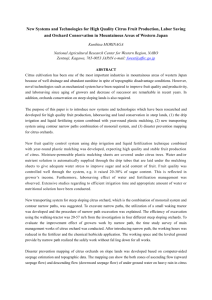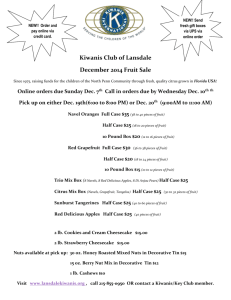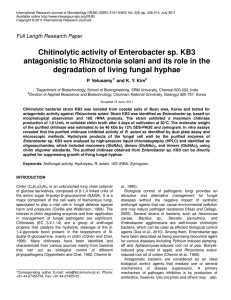plant defensive proteins and disease resistance in citrus
advertisement
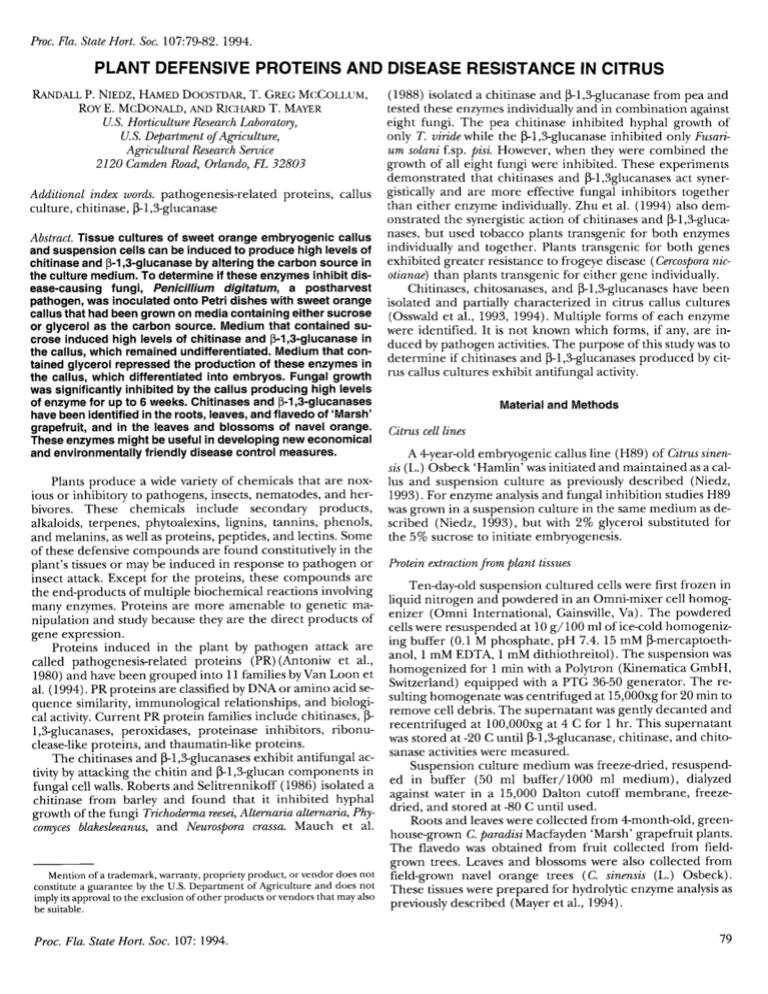
Proc. Fla. State Hort. Soc. 107:79-82. 1994.
PLANT DEFENSIVE PROTEINS AND DISEASE RESISTANCE IN CITRUS
Randall P. Niedz, Hamed Doostdar, T. Greg McCollum,
(1988) isolated a chitinase and (3-1,3-glucanase from pea and
Roy E. McDonald, and Richard T. Mayer
tested these enzymes individually and in combination against
U.S. Horticulture Research Laboratory,
eight fungi. The pea chitinase inhibited hyphal growth of
U.S. Department of Agriculture,
only T. viride while the (3-1,3-glucanase inhibited only Fusari-
Agricultural Research Service
um solani f.sp. pisi However, when they were combined the
2120 Camden Road, Orlando, FL 32803
growth of all eight fungi were inhibited. These experiments
Additional index zuords. pathogenesis-related proteins, callus
gistically and are more effective fungal inhibitors together
demonstrated that chitinases and (3-l,3glucanases act synerculture, chitinase, |3-l,3-glucanase
Abstract. Tissue cultures of sweet orange embryogenic callus
and suspension cells can be induced to produce high levels of
chitinase and (3-1,3-glucanase by altering the carbon source in
the culture medium. To determine if these enzymes inhibit dis
ease-causing fungi, Penicillium digitatum, a postharvest
pathogen, was inoculated onto Petri dishes with sweet orange
callus that had been grown on media containing either sucrose
or glycerol as the carbon source. Medium that contained su
crose induced high levels of chitinase and [3-1,3-glucanase in
the callus, which remained undifferentiated. Medium that con
tained glycerol repressed the production of these enzymes in
the callus, which differentiated into embryos. Fungal growth
was significantly inhibited by the callus producing high levels
of enzyme for up to 6 weeks. Chitinases and (3-1,3-glucanases
have been identified in the roots, leaves, and flavedo of 'Marsh'
grapefruit, and in the leaves and blossoms of navel orange.
These enzymes might be useful in developing new economical
and environmentally friendly disease control measures.
than either enzyme individually. Zhu et al. (1994) also dem
onstrated the synergistic action of chitinases and (3-1,3-glucanases, but used tobacco plants transgenic for both enzymes
individually and together. Plants transgenic for both genes
exhibited greater resistance to frogeye disease (Cercospora nicotianae) than plants transgenic for either gene individually.
Chitinases, chitosanases, and (3-1,3-glucanases have been
isolated and partially characterized in citrus callus cultures
(Osswald et al., 1993, 1994). Multiple forms of each enzyme
were identified. It is not known which forms, if any, are in
duced by pathogen activities. The purpose of this study was to
determine if chitinases and (3-1,3-glucanases produced by cit
rus callus cultures exhibit antifungal activity.
Material and Methods
Citrus cell lines
A 4-year-old embryogenic callus line (H89) of Citrus sinensis (L.) Osbeck 'Hamlin' was initiated and maintained as a cal
Plants produce a wide variety of chemicals that are nox
ious or inhibitory to pathogens, insects, nematodes, and her
bivores. These chemicals include secondary products,
alkaloids, terpenes, phytoalexins, lignins, tannins, phenols,
and melanins, as well as proteins, peptides, and lectins. Some
of these defensive compounds are found constitutively in the
plant's tissues or may be induced in response to pathogen or
insect attack. Except for the proteins, these compounds are
the end-products of multiple biochemical reactions involving
many enzymes. Proteins are more amenable to genetic ma
nipulation and study because they are the direct products of
gene expression.
Proteins induced in the plant by pathogen attack are
called pathogenesis-related proteins (PR)(Antoniw et al.,
1980) and have been grouped into 11 families by Van Loon et
al. (1994). PR proteins are classified by DNA or amino acid se
quence similarity, immunological relationships, and biologi
cal activity. Current PR protein families include chitinases, (31,3-glucanases, peroxidases, proteinase inhibitors, ribonuclease-like proteins, and thaumatin-like proteins.
The chitinases and |3-l,3-glucanases exhibit antifungal ac
tivity by attacking the chitin and (3-1,3-glucan components in
fungal cell walls. Roberts and Selitrennikoff (1986) isolated a
chitinase from barley and found that it inhibited hyphal
growth of the fungi Trichoderma reesei, Alternaria alternaria, Phycomyces blakesleeanus, and Neurospora crassa. Mauch et al.
Mention of a trademark, warranty, propriety product, or vendor does not
constitute a guarantee by the U.S. Department of Agriculture and does not
imply its approval to the exclusion of other products or vendors that may also
be suitable.
Proc. Fla. State Hort. Soc. 107: 1994.
lus and suspension culture as previously described (Niedz,
1993). For enzyme analysis and fungal inhibition studies H89
was grown in a suspension culture in the same medium as de
scribed (Niedz, 1993), but with 2% glycerol substituted for
the 5% sucrose to initiate embryogenesis.
Protein extraction from plant tissues
Ten-day-old suspension cultured cells were first frozen in
liquid nitrogen and powdered in an Omni-mixer cell homog-
enizer (Omni International, Gainsville, Va). The powdered
cells were resuspended at 10 g/100 ml of ice-cold homogeniz
ing buffer (0.1 M phosphate, pH 7.4, 15 mM (3-mercaptoethanol, 1 mM EDTA, 1 mM dithiothreitol). The suspension was
homogenized for 1 min with a Polytron (Kinematica GmbH,
Switzerland) equipped with a PTG 36-50 generator. The re
sulting homogenate was centrifuged at 15,000xg for 20 min to
remove cell debris. The supernatant was gently decanted and
recentrifuged at 100,000xg at 4 C for 1 hr. This supernatant
was stored at-20 C until (3-1,3-glucanase, chitinase, and chitosanase activities were measured.
Suspension culture medium was freeze-dried, resuspend
ed in buffer (50 ml buffer/1000 ml medium), dialyzed
against water in a 15,000 Dal ton cutoff membrane, freezedried, and stored at -80 C until used.
Roots and leaves were collected from 4-month-old, green
house-grown C. paradisi Macfayden 'Marsh' grapefruit plants.
The flavedo was obtained from fruit collected from fieldgrown trees. Leaves and blossoms were also collected from
field-grown navel orange trees (C. sinensis (L.) Osbeck).
These tissues were prepared for hydrolytic enzyme analysis as
previously described (Mayer et al., 1994).
79
Protein determination followed the method of Bradford
(1976). A standard curve in the range of 0-20 \lg was con
structed using bovine serum albumin as the standard.
Table 1. Specific activity of chitinase and (5-1,3-glucanase in 'Hamlin' sweet
orange cell and embryo cultures (H89). Data are the mean ± SE.
Chitinase assay
Medium
10 min at 45 C. Reaction mixtures contained 100 jlx.1 of blue
chitin suspension, 0.1-0.5 |Llg protein and enough 0.2 M sodi
um acetate buffer (pH 5) to bring the volume to 0.5 ml in microcentrifuge tubes. Reactions were terminated using 100 |LXl
of chilled 1 N HC1. The reactions mixtures were centrifuged
at 10,000 g for 2 min and the absorbance of the supernatants
Cells/Embryos
f}-l,3-Glucanase assay
(3-1,3-Glucanase activity was determined by the method of
Abeles and Forrence (1970) using laminarin as the substrate
and a dinitrosalicylic acid reagent to measure the reducing
sugars. p-l,3-glucanase activity is reported as the release of |lg
(5-1,3-Glucanase
(AAs50«min"1-mg protein"1)
(|J.g glomin'-mg protein')
Glycerol
Chitinase activity was measured as previously reported us
ing blue chitin (Saborowski et al., 1993). Reaction times were
recorded at 550 nm. Activities are reported as AA550-minting
protein"1.
Chitinase
Samples
14 ±3
694 ±108**
Sucrose
Glycerol
251 ±31A
4±3
47 ±14
84 ± 26
Sucrose
699 ± 365A
93 ± 8
AP<0.01 by Student's Hest.
ggQmg protein"1 for chitinase and 699 (Xg glc• min"1-nig
protein"1 of (3-1,3-glucanase) were measured in the medium of
the sucrose grown cells. Conversely, low levels of both en
zymes (14 AA550-minting protein of chitinase and 4 |ig
glc-min^mg protein1 of (3-1,3-glucanase) were measured in
the medium of the glycerol grown embryos. There was no dif
ference in (}-l ,3-glucanase activity between the sucrose grown
cells or the glycerol grown embryos. Chitinase activity was sig
glucose(Glc) -minting protein"1.
nificantly higher (694 AA^Q-rnin^-mg protein *) in the glycerol
grown embryos than in sucrose grown cells (47 AA550»min"1«mg
protein1).
Fungal growth and inoculation
in the medium of glycerol-grown embryos compared to levels
A monosporic culture of P. digitatum was maintained in
The extremely low levels of chitinase and (i-l,3-glucanase
in the medium of sucrose-grown cells made it possible to test
the possible antifungal activity of these 2 enzymes. A signifi
the dark at 25 C on potato dextrose agar (Dhingra and Sin
cant inhibition of fungal mycelial growth would be expected
clair, 1985). The fungus was grown in 60 x 15 mm Petri dishes
to occur on culture medium containing high levels of chiti
until the surface of the plate was covered with mycelium. Agar
nase and (3-1,3-glucanase. P. digitatum, a fungal pathogen that
plugs (9 mm) were extracted aseptically with a #5 cork borer
attacks fruit in postharvest situations, was therefore grown in
and used to inoculate culture plates containing citrus callus.
the presence of the 2 sweet orange cell lines that differed
markedly in the amounts of chitinase and (3-1,3-glucanase re
leased into their respective culture media. Agar plugs con
taining P. digitatum mycelium were placed onto culture
medium (MS salts and vitamins + 2% glycerol) with either low
chitinase and low p-l,3-glucanase producing, glycerol-grown
globular embryos or high chitinase and high p-l,3-glucanase
producing sucrose-grown cells. After the plates were incubat
ed in the dark for 6 weeks the growth of the fungus was eval
About 1 g of sucrose- or glycerol-grown suspension cells
were collected and inoculated onto culture medium supple
mented with 2% glycerol. The cells were placed near one side
of the culture dish. A single agar plug containing fungal
mycelium was placed on the opposite side of each dish. Plates
containing both citrus cells and P. digitatum were incubated in
the dark at 27 C for 6 weeks.
Results and Discussion
uated. A significant reduction in hyphal growth was observed
in the plates where the fungus was co-cultured in the pres
entiation occurred rapidly as embryo primordia were visible
ence of the high chitinase and high (3-1,3-glucanase produc
ing cells (Figure IB). No reduction in growth was observed
when the fungus was co-cultured with the low chitinase and
low p-l,3-glucanaseproducing embryos (Figure 1A). Fungal
growth remained inhihited for up to 6 weeks, after which the
within 6 days upon transfer to the glycerol-based medium The
plates were discarded.
H89 cells were grown in 2 suspension culture media that
varied only in the carbon source used, i.e. either glycerol or
sucrose. The H89 cells grown in the glycerol-based medium
differentiated into globular-stage embryos in 6 weeks. Differ
type and concentration of carbohydrate used as a carbon
source has a significant influence on initiating somatic embryogenesis in citrus nucellar-derived tissue cultures (Kochba
et al., 1982), with glycerol being the most effective (BenHayyim and Neumann, 1983). No embryogenesis was ob
served in the sucrose-based medium that was used to main
Table 2. Specific activity of chitinase and b-1,3-glucanase in 'Marsh' grape
fruit roots, leaves, and flavedo. Data are the mean ± SE.
Samples
tain the H89 cell line. This resulted in 2 cell lines - an embryo
suspension culture maintained in a glycerol-based medium
and an undifferentiated cell suspension culture maintained
in a sucrose-based medium.
Chitinase and (3-1,3-glucanase specific activity were mea
Chitinase
(3-1,3-Glucanase
(AA550-min"'-mg protein"1)
(|ig glc-min'-mg protein1)
'Marsh' grapefruit
8.4 ±2.0
901.5 ±69.5
leaves
16.2 ±0.6
14,820 ±67.0
flavedo
14.9 ±1.8
9,294 ±1,765
roots
sured in the callus cells and embryos and the culture medium
Navel orange
of each (Table 1), and in the roots, leaves, and flavedo of
old leaves
4.4 ±2.1
28.6 ±20.7
'Marsh' grapefruit and new and old leaves and blossoms of na
vel orange (Table 2). High levels of both enzymes (251
new leaves
1.9 ±0.9
1.0 ±0.3
blossom
1.7±0.9
1.4 ±0.6
80
Proc. Fla. State Hort. Soc. 107: 1994.
B
A
Figure 1. Six week old cultures of P. digitatumon MS salts and vitamins + 2% glycerol culture medium with H89 cells or embryos. A) Low chitinase and p-
1,3-glucanase producing H89 cell line. Cells grown on glycerol medium for 6 weeks to induce embryo formation before transfer to the same medium (i.e. MS
salts and vitamins + 2% glycerol). B) High chitinase and |3-l,3-glucanase producing H89 cell line. Cells grown on sucrose before transfer to MS salts and vita
mins + 2% glycerol.
The growth inhibition observed in the presence of the
high chitinase and (5-1,3-glucanase producing cells is consis
tent with the known effects of these enzymes on fungal
growth (Mauch et al., 1988). However, this experiment does
not eliminate the possibility that another factor(s) was re
sponsible for the inhibition of fungal growth. There may be
significant differences between H89 cells grown on sucrose
and H89 embryos grown on glycerol other than in levels of
chitinase and (3-1,3-glucanase activity. For example, the pro
duction of volatiles, other secondary products, or pH gradi
ent differences might also inhibit fungal growth. Fungal
inhibition assays using the purified hydrolases would be nec
essary to demonstrate the specific contribution of these en
so, this strategy of improving a tree's disease resistance should
be environmentally friendly as eliciting compounds are gen
erally nontoxic.
Acknowledgments
We would like to thank Ms. Tricia Farley, Ms. Monique
Doherty, and Dr. Elizabeth Berdis for their assistance in the
laboratory. Partial funding for this work was made available
from the Citrus Production Research Marketing Order by the
Division of Marketing and Development, Florida Department
of Agriculture and Consumer Services, Bob Crawford, Com
missioner.
zymes.
These results strongly suggest the possibility of improving
Literature Cited
disease resistance by raising the endogenous chitinase and P~
1,3-glucanase levels in citrus plants. We examined chitinase
and P-l,3-glucanase levels in plant parts of 'Marsh' grapefruit
and navel orange to establish that the enzymes were present
in a commercial citrus variety (Table 2). (3-1,3-Glucanase ac
tivity was 14,820 and 9,294,|ig glc-min^mg1 protein as mea
sured in the leaves and flavedo of 'Marsh' grapefruit,
respectively. Unlike [3-1,3-glucanase, chitinase activity was very
Antoniw, J. F., Ritter, C. E., Pierpoint, W. S. and Van Loon, L. C. 1980. Com
parison of three pathogenesis-related proteins from plants of two cultivars
of tobacco infected with TMV. Phytopathol. Z. 98:331-341.
Ben-Hayyim, G., Neumann, H. 1983. Stimulatory effect of glycerol on growth
and somatic embryogenesis in citrus callus cultures. Z. Pflanzenphysiol.
110:331-337.
Dhingra, O. D., Sinclair, J. B. 1985. Basic Plant Pathology Methods. CRC
Press, Boca Raton.
low (< 20 AA^o-min^mg protein1) in the three tissues sam
Mayer, R. T., Shapiro, J. P., Berdis, E., Hearn, C. J., McCollum, T. G., Mc
pled from 'Marsh' grapefruit. Chitinase and (3-1,3-glucanase
levels were also very low in the old and new leaves and blos
Mauch, F., Mauch-Mani, B., and Boiler, T. 1988. Antifungal hydrolases in pea
soms of navel orange.
The glycerol-grown embryo cell line may be useful for the
in vitro screening of compounds that elicit the production of
these antifungal compounds in citrus. Tissue culture-derived
embryos would be expected to respond more like the whole
plant than nondifferentiated cells. Such screening would be
both more cost effective and efficient than field screening. Al
Proc. Fla. State Hort. Soc. 107: 1994.
Donald, R. E., and Doostdar, H. Responses to herbivory by larvae of the
sugarcane rootstock borer weevil {Diaprepes abbreviatus L.). Submitted.
tissue. II Inhibition of fungal growth by combinations of chitinase and $1,3-glucanase. Plant Physiol. 88:936-942.
Niedz, R. P. 1993. Culturing embryogenic protoplasts of 'Hamlin' sweet or
ange in calcium alginate beads. Plant Cell, Tissue and Organ Culture
34:19-25.
Osswald, W. F., Shapiro, J. P., McDonald, R. E., Niedz, R. P., and Mayer, R. T.
1993. Some citrus chitinases also possess chitosanase activities. Experientia 49:888-892.
81
Osswald, W. F., Shapiro, J. P., Doostdar, H., McDonald, R. E., Niedz, R. P.,
Nairn, C. J., Hearn, C. J., and Mayer, R. T. 1994. Identification and char
acterization of acidic hydrolases with chitinase and chitosanase activities
from sweet orange callus tissue. Plant Cell Physiol. 35:811-820.
Roberts, W. K., Selitrennikoff, C. P. 1986. Isolation and partial characteriza
tion of two antifungal proteins from barley. Biochim. Biophys. Acta
880:161-170.
Saborowski, R., Buchholz, F., Vetter, R.-AH., Wirth, S. J., and Wolf, G. A.
1993. A soluble, dye-labelled chitin derivative adapted for the assay of krill
chitinase. Comp. Biochem. Physiol. 105B:673-678
Van Loon, L. C, Pierpoint, W. S., Boiler, Th., and Conejero, V. 1994. Recom
mendations for naming plant pathogenesis-related proteins. Plant Molec.
Biol. Reptr. 12:245-264.
Zhu, Q., Maher, E. A., Masoud, S., Dixon, R. A., and Lamb, C. J. 1994. En
hanced protection against fungal attack by constitutive co-expression of
chitinase and glucanase genes in transgenic tobacco. Bio/Technology
12:807-812.
Proc. Fla. State Hort. Soc. 107:82-85. 1994
EFFECTS OF SEAWEED SPRAYS ON CITRUS FRUIT PRODUCTION1
Robert C.J.Koo2
University of Florida. IFAS
Citrus Research and Education Center
700 Experiment Station Road
Lake Alfred, FL 33850
Steven Mayo
Mayo Grove Management
6601 North Blvd.
Ft. Pierce. FL 34951
Additional index words. Citrus, fruit yield, fruit drop
Abstract. The effect of seaweed sprays were evaluated on or
ange and grapefruit trees. Trees sprayed with seaweed ex
tracts increased fruit production 10-25% over that of the
control. A combination of prebloom, postbloom, and summer
sprays appeared to give greater response in fruit production
than other timing treatments. Trees sprayed with seaweed ex
tracts had fewer premature fruit drop than the control. Fruit
size from seaweed treated trees were equal or larger than fruit
from the control trees, despite the fact that higher fruit produc
tion is usually accompanied by smaller sized fruit. In general,
rind color break occurred earlier in fruit from the seaweed
treated trees than fruit from the control trees.
Seaweed-based products have been used on agricultural
crops in the United States as an organic fertilizer supplement.
Increased yield of poato and corn with seaweed sprays have
been reported (Chapman and Chapman, 1980). Increased
shelf life of peaches have been reported from trees sprayed
with seaweed extracts (Skelton and Senn, 1966). In Florida
trials, seaweed sprays increased total yield as well as early ma
turity of tomatoes (Csizinszky, 1984).
In citrus, under controlled greenhouse conditions, sea
weed extract sprayed at a dilution of 1:25 parts of extract and
water corrected Mg, Mn, Zn, and B deficiency symptoms (Ait-
ken and Senn, 1964). A 3-yr field study of seaweed extract on
young Sunburst tangerines showed a 30% increase in fruit
production (Koo, 1988). Studies were initiated in 1991 to
study the effects of seaweed sprays on oranges and grapefruit.
'The authors are grateful to Ben Hill Griffin, Inc.; Hancock-Fidelity Cit
rus, Ltd.; and VTA Tropical Fruits, Inc. for the splendid cooperation in sup
plying the groves and assistance for these studies.
^Professor Emeritus.
82
This paper summarizes the data from 3 experiments over a 2to 3-yr period.
Materials and Methods
Three experiments were initiated in central (Polk Coun
ty), east coast (Martin County) and southwest (Hendry Coun
ty) regions of Florida to study the effects of seaweed sprays on
oranges and grapefruit growing under different production
conditions. Experiment 1 was conducted on Washington Na
vel orange [Citrus sinensis (L) Osbeck] and Ruby Red grape
fruit {CitrusparadisiMacf) on sour orange {Citrus aurantium)
rootstock near Frostproof, Florida. The trees were planted in
1980 on single beds at a 17/2 x 30 foot spacing. Experiment
2 was located near LaBelle, Florida using Ruby Red grapefruit
{Citrus paradisi Macf) on Carrizo citrange [Poncirus trifoliata
(L) Raf x C. sinensis] rootstock planted on double beds. The
trees were planted in 1987 at 15 x 20 foot spacing. Experi
ment 3 was located near Indiantown, Florida using Hamlin
and Pineapple oranges. Hamlin orange [Citrus sinensis (L)
Osbeck] on Cleopatra mandarin (C. reticulata Blanco) rootstock were planted in 1980 on double beds with a tree spacing
of 15 x 22lA feet. Pineapple orange [Citrus sinensis (L) Os
beck] on rough lemon {Citrus jambhiri) rootstock were plant
ed on single beds in 1962 using a 20 x 25 foot spacing.
Treatments of all 3 experiments are listed in Table 1 together
with the mineral compositions of the seaweed extracts. Exper
imental design in all 3 experiments was complete randomized
block. Each treatment was replicated 4 times using 6-tree
plots. Experiments 1 and 2 were designed to obtain informa
tion on the best timing to apply seaweed extracts. Experiment
3 was a comparison of seaweed sprays and gibberellic acid as
foliar sprays.
Fruit production data were collected at the time of fruit
harvest. Fruit samples were collected 1-2 weeks before fruit
was harvested to measure quality. Premature fruit drops were
counted 3-4 times a year at 5-6 week intervals. Only the freshly
dropped fruit were counted. Fruit size and fruit color were
measured both in the laboratory and in the field. Leaf sam
ples were collected to evaluate the ability of seaweed extracts
to supply plant nutrients. Four- to five-month-old spring flush
leaves from nonfruiting terminals were collected in 1991 and
1992 for this purpose. Data from all 3 experiments were ana
lyzed by analysis of variance on an annual basis. The multiyear
average data were not analyzed. They are listed only to show
trends if any.
Proc. Fla. State Hort. Soc. 107: 1994.
